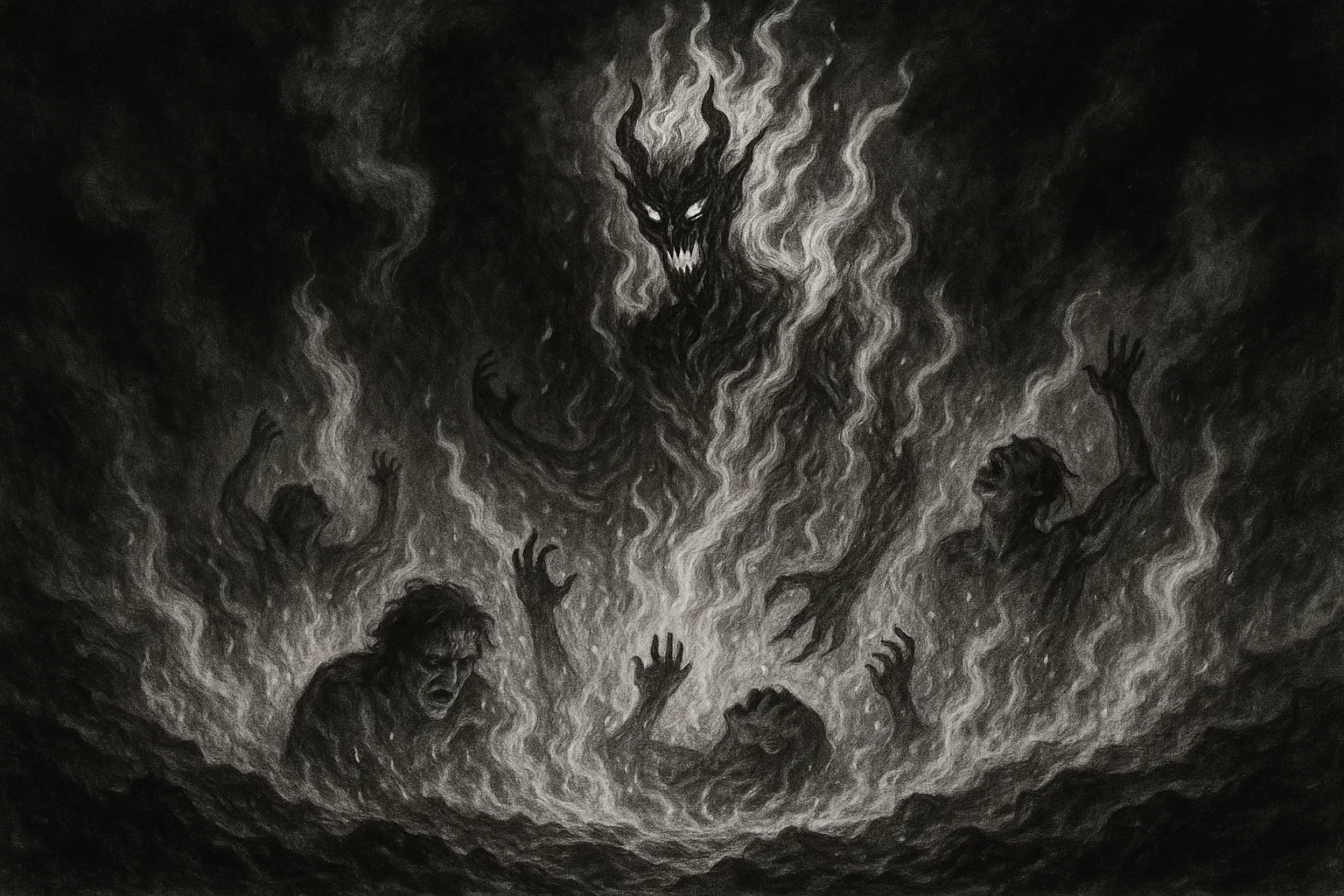In the shadowed realm of Goetic demonology, Amy (Avnas), also known as Auns, Hanar, or Hanni, reigns as a President of Hell, commanding 36 legions of spirits.
Emerging first as a blazing flame, the demon Amy transforms into a human form at the summoner’s command, ready to impart profound knowledge of astronomy and liberal arts, provide loyal familiars, and reveal treasures guarded by spirits. His story, chronicled in ancient grimoires like the Ars Goetia and Pseudomonarchia Daemonum, weaves a narrative of intellectual brilliance and infernal power.
Summary
Key Information About the Demon Amy
| Attribute | Details |
|---|---|
| Name | Amy (Avnas, Auns, Hanar, Hanni) |
| Titles | President of Hell |
| Appearance | Initially a flame, then a human form |
| Pantheon | Goetic Demonology |
| Equipment/Tools | None specified |
| Associated Gem | Ruby (fire, vitality), Sapphire (wisdom) |
| Associated Color | Red (fire), Blue (knowledge) |
| Astrological Influence | Mercury (knowledge), Fire signs: Aries, Leo, Sagittarius |
| Equivalents | Possible links to wisdom deities (e.g., Thoth, Athena, speculative) |
| Alignment | Neutral |
| Opposing Angel/Saint | Ieialel (Shem HaMephorash) / Saint Thomas Aquinas |
| Number of Legions | 36 |
| Superior Demon | Lucifer or Satanachia |
| Region of Hell | Not specified |
What Is the Meaning of Amy’s Name?
The etymology of Amy (Avnas)’s name remains shrouded in mystery, enhancing his enigmatic presence in Goetic tradition.
Alternate names—Avnas, Auns, Hanar, and Hanni—reflect scribal variations across medieval texts, possibly rooted in Latin, Hebrew, or other ancient languages.
One theory suggests a connection to the Latin amare (to love), implying that the demon Amy possesses a charismatic influence capable of swaying rulers or fostering favor, aligning with his ability to procure positive reactions from authority figures.
You May Also Like: Smurl Family Haunting: A Demonic Nightmare in Pennsylvania
Another possibility points to Hebrew roots, such as “emunah” (faith) or terms related to knowledge, reflecting his role as a teacher of astronomy and liberal arts.
The name Avnas may derive from a corruption of Auns, potentially linked to occult terms for wisdom or enlightenment, though no definitive meaning is confirmed.
Historical and Mythological Background
The demon Amy (Avnas) originates from the celestial rebellion that defines Goetic demonology, a tradition rooted in Christian narratives of fallen angels.
According to Pseudomonarchia Daemonum (1577), Amy (Avnas) was once an angel of the order of Powers, a celestial choir in the second sphere tasked with maintaining cosmic order, regulating celestial movements, and protecting against malevolent forces.
The Powers’ role in overseeing the universe’s harmony aligns with the demon Amy’s expertise in astronomy, a science concerned with the stars and cosmic patterns. His fall from grace, alongside other angels during Lucifer’s rebellion, transformed him into a President of Hell, redirecting his celestial knowledge to serve mortal summoners.
This rebellion, often depicted as a pre-human cosmic conflict, is a cornerstone of demonological lore, with texts like The Book of Enoch (c. 300 BCE) describing the fall of angels who defied divine will.
Amy (Avnas)’s transition from an angel of order to an infernal president reflects the complex interplay between his divine origins and demonic role, a duality common among Goetic demons.
His claim, noted in Pseudomonarchia Daemonum and Dictionnaire Infernal, that he hopes to return to the seventh heaven after 1,200 years, adds a poignant dimension to his character. Johann Weyer dismisses this hope as “not credible,” arguing that damned entities cannot reclaim their celestial status, yet this aspiration humanizes the demon Amy, suggesting a lingering connection to his angelic past.
In medieval Europe, during the Renaissance and witch trial era (15th–17th centuries), the demon Amy (Avnas) would have been a valuable ally for scholars, alchemists, and occultists.
His ability to teach the liberal arts—encompassing the trivium (grammar, logic, rhetoric) and quadrivium (arithmetic, geometry, music, astronomy)—aligned with the period’s revival of classical learning, making him a patron of intellectual pursuits.
His power to reveal treasures guarded by spirits appealed to those seeking material wealth in an era of economic instability, while his capacity to procure favor from rulers offered strategic advantages in political or social contexts.
Amy (Avnas)’s mythological connections are speculative, as he lacks clear equivalents like Amon’s link to Amun-Ra. Some scholars propose a tenuous tie to wisdom deities, such as the Egyptian Thoth, god of knowledge and writing, due to the demon Amy’s intellectual powers.
Thoth’s association with the moon and cosmic order parallels Amy (Avnas)’s astronomical expertise, though no direct evidence supports this connection.
Similarly, the Greek Athena, goddess of wisdom and strategy, shares Amy (Avnas)’s focus on learning, but her martial aspects diverge from his fiery, treasure-revealing nature.
Unlike Baal, derived from Canaanite gods, the demon Amy appears to be a creation of the grimoire tradition, possibly inspired by the demonization of pagan deities or celestial archetypes in Christian theology.
His fiery appearance suggests an elemental archetype, synthesizing destruction and enlightenment, crafted to embody the allure of forbidden knowledge.
Historical Mentions of the Demon Amy
The demon Amy (Avnas) appears in several key demonological texts, each contributing to his portrayal as a knowledgeable and powerful president.
You May Also Like: The Cursed Noh Mask | Horror Story
The following table expands on these mentions, incorporating additional grimoires where Amy (Avnas) or similar entities are referenced:
| Text/Grimoire | Year | Description | Notable Details |
|---|---|---|---|
| The Book of Abramelin | c. 1450 | Possible reference to Amy as a subordinate spirit under Astaroth and Asmodeus, associated with knowledge and treasures | Attributed to Abraham of Worms; translated by S.L. MacGregor Mathers in 1898; focuses on the Holy Guardian Angel rite, with Amy potentially linked to intellectual pursuits |
| Liber Officiorum Spirituum | c. 1530–1583 | Lists Amy or a similar spirit as a president, associated with teaching and revealing secrets | Early grimoire predating Weyer’s work; influential in shaping Pseudomonarchia Daemonum; compiled from 15th–16th-century manuscripts |
| Pseudomonarchia Daemonum | 1577 | Great president, appears as a flame then human, teaches astrology and liberal sciences, gives good familiars, reveals treasures, governs 36 legions, hopes to return to seventh throne in 1,200 years (not credible) | Authored by Johann Weyer; written during the witch trial era, reflecting demonological fascination |
| Ars Goetia (Lesser Key of Solomon) | c. 1650 | 58th spirit, Great President, appears as flaming fire then man, teaches astrology and liberal sciences, gives good familiars, reveals treasures kept by spirits, governs 36 legions | Compiled from earlier sources; edited by S.L. MacGregor Mathers and Aleister Crowley in 1904; key Renaissance occult text |
| Dictionnaire Infernal | 1863 | Great president and prince of hell, appears as flames then human, teaches astrology and liberal arts, gives good familiars, reveals treasures, commands 36 legions, hopes to return to seventh throne | Authored by Jacques Collin de Plancy; 6th edition illustrated by Louis Le Breton, shaping modern visual depictions |
Pseudomonarchia Daemonum (1577, Johann Weyer):
“Amy is a great president, and appeareth in a flame of fier, but having taken mans shape, he maketh one marvelous in astrologie, and in all the liberall sciences, he procureth excellent familiars, he bewraieth treasures preserved by spirits, he hath the government of thirtie six legions, he is partlie of the order of angels, partlie of potestates, he hopeth after a thousand two hundred yeares to returne to the seventh throne: which is not credible.”
Ars Goetia (17th century):
“The Fifty-eighth Spirit is Amy, or Avnas. He is a Great President, and appeareth at first in the Form of a Flaming Fire; but after a while he putteth on the Shape of a Man. His office is to make one Wonderful Knowing in Astrology and all the Liberal Sciences. He giveth Good Familiars, and can bewray Treasure that is kept by Spirits. He governeth 36 Legions of Spirits, and his Seal is this”.
Dictionnaire Infernal (1863, Jacques Collin de Plancy):
“Amy, grand président et l’un des princes de l’empire infernal, apparaît dans une flamme de feu, et peut prendre la forme humaine. Il enseigne l’astrologie et les arts libéraux, donne de bons esprits familiers, révèle les trésors gardés par les démons, et commande trente-six légions. Il espère, après douze cents ans, remonter au septième trône, ce qui, selon Wierus, n’est pas croyable.”
Translation (for context):
“Amy, great president and one of the princes of the infernal empire, appears in a flame of fire and can take human form. He teaches astrology and liberal arts, gives good familiars, reveals treasures guarded by demons, and commands thirty-six legions. He hopes, after twelve hundred years, to return to the seventh throne, which, according to Wierus, is not believable.”
What Does the Demon Amy Look Like?
The demon Amy (Avnas) presents a striking duality in his appearance, reflecting his fiery and intellectual nature.
Initially, he manifests as a roaring flame, a potent symbol of destruction, transformation, and divine illumination in many cultural traditions. Fire, associated with knowledge and revelation, underscores Amy (Avnas)’s role as a teacher of astronomy and liberal arts. Upon the summoner’s command, he assumes a human form, facilitating communication and the exchange of wisdom.
You May Also Like: The Smiling Man | Horror Story
The Ars Goetia notes: “He appeareth at first in the Form of a Flaming Fire; but after a while he putteth on the Shape of a Man.” This transformation from an elemental blaze to a human figure highlights Amy (Avnas)’s ability to bridge primal power and intellectual clarity.
While grimoires do not specify details of his human form, occult interpretations often depict him as a scholarly figure with an aura of fiery intensity, reflecting his celestial origins and infernal authority.
Powers and Abilities
The demon Amy (Avnas) wields a formidable array of powers, centered on intellectual enlightenment, spiritual assistance, and material gain:
- Teaching Astronomy and Liberal Arts: Amy (Avnas) imparts mastery of the liberal arts, encompassing the trivium (grammar, logic, rhetoric) and quadrivium (arithmetic, geometry, music, astronomy). In the Renaissance context, these disciplines were the cornerstone of scholarly education, making Amy (Avnas) a patron of intellectual excellence. His expertise in astronomy, the study of celestial bodies and cosmic patterns, aligns with his angelic origins in the order of Powers, who oversaw celestial order.
- Providing Good Familiars: Amy (Avnas) grants “good familiars,” spiritual entities that assist summoners in tasks such as divination, protection, or magical operations. These familiars are noted for their reliability, enhancing the practitioner’s capabilities and ensuring successful outcomes.
- Revealing Treasures: The demon Amy can disclose the locations of treasures guarded by other spirits, offering material wealth to summoners. This power, absent in some texts like the Munich Manual of Demonic Magic, is a hallmark of his role as a facilitator of hidden riches, appealing to those seeking economic gain.
- Influencing Rulers: Amy (Avnas) can incite positive reactions from rulers, suggesting a charismatic or persuasive influence. This ability, noted in Pseudomonarchia Daemonum, positions him as a valuable ally for navigating political or social hierarchies, offering strategic advantages in courtly or diplomatic contexts.
- Spiritual Insight: As a former angel of the Powers, Amy (Avnas) retains a deep understanding of cosmic and spiritual matters, which he channels into his teachings and revelations. This insight makes him a guide for those exploring esoteric knowledge or seeking to understand the universe’s mysteries.
These powers highlight Amy (Avnas)’s dual role as a purveyor of wisdom and a conduit for material gain, making him a versatile figure in Goetic practice. His intellectual focus distinguishes him from demons like Agares, who wield elemental powers, or Asmodai, known for martial and scientific expertise.
Role in the Hierarchy of Hell
As a President of Hell, the demon Amy (Avnas) holds a significant rank within the infernal hierarchy, commanding 36 legions, each comprising thousands of spirits.
In Goetic tradition, Presidents are associated with knowledge, communication, and administration, overseeing specific functions within Hell’s feudal structure. Amy (Avnas)’s role centers on the dissemination of intellectual wisdom and the allocation of spiritual resources, such as familiars.
You May Also Like: Is the Cahaba River Monster Real? Sightings, Theories, and Legend
He likely serves under a higher-ranking demon, such as Lucifer or Satanachia, the latter mentioned in Grimorium Verum as overseeing presidents and dukes.
His position as a former Power underscores his authority, as the Powers were among the higher angelic choirs, tasked with cosmic governance. This celestial background enhances Amy (Avnas)’s prestige, distinguishing him from lower-ranking demons like Akesoli or martial ones like Bael.
Astrological Associations and Correspondences
While traditional grimoires do not explicitly assign astrological associations to Amy (Avnas), his powers and fiery appearance suggest several connections.
The planet Mercury, governing intellect, communication, and learning, is a primary influence due to the demon Amy’s role as a teacher of astronomy and liberal arts.
His initial form as a flame aligns with the Fire element, symbolizing transformation, passion, and enlightenment, which corresponds to fire signs: Aries (initiative, March 21–April 19), Leo (leadership, July 23–August 22), and Sagittarius (exploration, November 22–December 21). These signs, ruled by Mars, the Sun, and Jupiter, reflect Amy (Avnas)’s dynamic and illuminating nature.
Amy (Avnas)’s correspondences enhance his ritualistic significance:
- Colors: Red (fire, passion) and blue (wisdom, clarity) symbolize his dual nature as a fiery entity and intellectual guide.
- Gems: Ruby (vitality, strength) and sapphire (wisdom, intuition) resonate with his fiery and scholarly attributes.
- Metals: Gold (illumination, solar energy) and mercury (fluidity, communication) align with his celestial and communicative roles.
- Herbs: Frankincense (spiritual elevation), saffron (enlightenment), and rosemary (mental clarity) are suitable for rituals.
- Incense: Dragon’s blood (power), sandalwood (clarity), and copal (spiritual connection) enhance his presence.
- Animals: Phoenix (fire, rebirth) and owl (wisdom, insight) symbolize his transformative and intellectual qualities.
- Time of Power: Wednesday (Mercury’s day), fire sign seasons (spring for Aries, summer for Leo, late fall for Sagittarius), waxing moon phases for growth, or midnight for esoteric focus.
The following table summarizes these correspondences:
| Correspondence | Associated Item | Meaning |
|---|---|---|
| Planet | Mercury | Intellect, communication |
| Element | Fire | Transformation, passion |
| Zodiac Signs | Aries, Leo, Sagittarius | Initiative, leadership, exploration |
| Day of Week | Wednesday | Ruled by Mercury |
| Colors | Red, Blue | Red: Fire, passion; Blue: Wisdom, clarity |
| Gems | Ruby, Sapphire | Ruby: Vitality, strength; Sapphire: Wisdom, intuition |
| Metals | Gold, Mercury | Gold: Illumination; Mercury: Fluidity, communication |
| Herbs | Frankincense, Saffron, Rosemary | Frankincense: Spiritual elevation; Saffron: Enlightenment; Rosemary: Mental clarity |
| Incense | Dragon’s Blood, Sandalwood, Copal | Dragon’s Blood: Power; Sandalwood: Clarity; Copal: Spiritual connection |
| Animals | Phoenix, Owl | Phoenix: Fire, rebirth; Owl: Wisdom, insight |
| Time of Power | Wednesday, Fire sign seasons, Waxing Moon, Midnight | Aligns with Mercury, fire energies, and esoteric focus |
How to Summon the Demon Amy?
Summoning Amy (Avnas) requires strict adherence to Goetic protocols, given his potent intellectual and material powers. The process involves several meticulous steps:
- Purification: The summoner must purify themselves through fasting (typically 24–48 hours), meditation, or ritual bathing with herbs like rosemary to ensure mental and spiritual clarity, aligning with Amy (Avnas)’s intellectual nature.
- Sigil Preparation: The demon Amy’s sigil, as depicted in the Ars Goetia, is drawn on parchment or engraved on a gold or copper disc, using red ink to symbolize his fiery essence. Precision is critical, as errors in the sigil can disrupt the ritual.
- Protective Circle: A circle of protection, approximately 9 feet in diameter, is created using chalk, salt, or consecrated earth, inscribed with sacred names (e.g., Tetragrammaton, Adonai) or symbols from the Key of Solomon to safeguard against unintended consequences.
- Invocations: Specific invocations, often in Latin or adapted from the Ars Goetia, are recited to call Amy (Avnas) forth. An example might include: “Amy, Great President of Hell, I summon thee by the power of thy seal to appear before me and grant my requests.” The summoner must state their intent clearly, whether for knowledge, familiars, or treasure.
- Offerings: Offerings enhance the ritual’s success, including frankincense or sandalwood incense, red or blue candles anointed with saffron oil, or symbolic items like a small astrolabe for astronomy. These align with Amy (Avnas)’s attributes and demonstrate respect.
- Communication: When Amy (Avnas) appears, initially as a flame, the summoner must request his human form for dialogue, as noted in Pseudomonarchia Daemonum: “having taken mans shape, he maketh one marvelous in astrologie.” Requests must be precise, and the summoner should maintain a commanding yet respectful demeanor.
- Banishing: Post-ritual, a banishing rite, such as the Lesser Banishing Ritual of the Pentagram or a verbal dismissal (“Depart in peace, Amy, and return whence thou camest”), ensures Amy (Avnas) leaves without lingering energies.
The Ars Goetia emphasizes the need for discipline, as Amy (Avnas)’s fiery nature and intellectual prowess demand a focused approach.
Sigil
The demon Amy (Avnas)’s sigil, as provided in the Ars Goetia, is a complex geometric design featuring intersecting lines, loops, and curves that symbolize his essence as a teacher and revealer.
You May Also Like: Yacumama: Could a 100-Foot Monster Still Be Hiding in the Amazon?
Drawn in red or gold ink to reflect his fiery and illuminating nature, the sigil is placed on the altar, engraved on a talisman, or worn during rituals to focus the summoner’s intent and establish a connection with Amy (Avnas).
Its intricate pattern mirrors his multifaceted role, bridging the primal energy of fire with the clarity of intellectual pursuit. Accuracy in replicating the sigil is paramount, as deviations can weaken the ritual’s efficacy.
Comparison of Amy with Other Demons
To contextualize Amy (Avnas)’s role, the following table compares him with eight other Goetic demons, highlighting differences in powers, ranks, and opposing angelic or saintly forces:
| Demon Name | Key Powers | Hierarchy Rank | Opposing Angel/Saint |
|---|---|---|---|
| Agares | Causes earthquakes, teaches languages, controls movement | Duke | Archangel Michael / Saint George |
| Akesoli | Inflicts pain, executes Amaimon’s commands | Servant | Archangel Uriel / None |
| Alloces | Teaches astronomy and liberal sciences, provides familiars | Duke | Archangel Michael / Saint Thomas Aquinas |
| Paimon | Teaches arts and sciences, grants visions | King | Archangel Raphael / Saint Augustine |
| Vassago | Reveals past and future, good-natured | Prince | Archangel Gabriel / Saint John the Baptist |
| Barbatos | Understands animal voices, finds treasures | Duke | Archangel Uriel / Saint Francis of Assisi |
| Bael | Grants invisibility, imparts wisdom | King | Archangel Raphael / Saint Benedict |
| Asmodai | Teaches geometry and sciences, reveals treasures | King | Archangel Raphael / Saint Anthony of Padua |
Conclusion
The demon Amy (Avnas), the fiery President of Hell, captivates with his blend of intellectual brilliance and mystical power. From his origins as a fallen angel of the order of Powers to his role in teaching astronomy, providing familiars, and revealing treasures, he embodies the allure of forbidden knowledge and material gain.
Chronicled in grimoires like Pseudomonarchia Daemonum, Ars Goetia, Dictionnaire Infernal, and potentially The Book of Abramelin, Amy (Avnas) remains a compelling figure in Goetic demonology.







